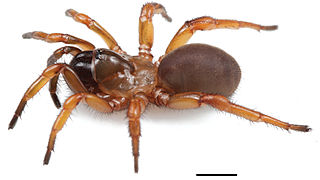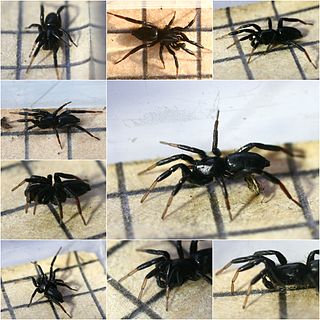
Oonopidae, also known as goblin spiders, is a family of spiders consisting of over 1,600 described species in about 113 genera worldwide, with total species diversity estimated at 2000 to 2500 species. The type genus of the family is OonopsKeyserling, 1835.

Liocranidae is a family of araneomorph spiders first described by Eugène Simon in 1897. They are one of several groups called "sac spiders". The holarctic genus Agroeca is the best-known, but it also includes various genera of more obscure spiders that still lack a diagnosis. Two species in the North American genus Neoanagraphis are found in the extremely dry conditions in the Mojave, Sonoran and Chihuahuan deserts. Females live in animal burrows while males wander and are the ones most often caught in pitfall traps.

Sphodros rufipes, sometimes called the red legged purseweb spider, is a mygalomorph spider from the southern United States, though it has been photographed as far north as Indiana, Missouri, New Jersey, Minnesota, Tennessee, Delaware, Louisiana, and Tuckernuck Island in Massachusetts [West Virginia]. A recent sighting shows that these spiders can also be found in Canada. Recent sighting also in Kansas.

Cesonia is a genus of ground spiders that was first described by Eugène Simon in 1893.

Myrmekiaphila is a genus of North American mygalomorph trapdoor spiders in the family Euctenizidae, and was first described by G. F. Atkinson in 1886. All described species are endemic to the southeastern United States.

Diguetia is a genus of coneweb spiders that was first described by Eugène Simon in 1895. Members of this genus are six-eyed spiders that are either white or patterned. They are common in the southwestern United States and Mexico, and one species is found in Argentina. In the United States, species have been found in Arizona, California, Nevada, New Mexico, and Texas. These spiders build a tubular retreat at the tip of their tent-like webs. Once an insect is caught in the web, the spider bites it and injects venom to stop its prey from moving, later wrapping it in silk. Both males and females use stridulation while mating, with females also stridulating when harassed. Two species of jumping spiders feed on its eggs. There are eleven Diguetia species.

Coneweb spiders (Diguetidae) are six-eyed haplogyne spiders that live in tangled space webs, fashioning a cone-like central retreat where they hide and lay eggs. It is a small family, containing only two genera with fifteen species and is confined to the New World, preferring deserts. Members of the genus Diguetia usually build their webs in shrubs or between cactus pads. They have the same eye arrangement as the venomous recluse spiders, but none are known to be harmful to humans.

Sphodros niger, the black purse-web spider, is a mygalomorph spider from the Eastern United States. It is listed as a special concern species in Connecticut.
Sphodros atlanticus is a species of spiders from the family Atypidae. It was described by Willis J. Gertsch and Norman I. Platnick in 1980. The species was described from specimens found in Georgia, North Carolina, Virginia and Illinois. It has also been found in Maryland and Alabama.

Gnaphosa is a genus of ground spiders that was first described by Pierre André Latreille in 1804. They all have a serrated keel on the retromargin of each chelicera.
Hexurella is a genus of spiders, found in the United States and Mexico. It is the only genus in the family Hexurellidae.

Micaria is a genus of ground spiders that was first described by Niklas Westring in 1851. They are 1.3 to 6.5 millimetres long.
Austrochilus is a genus of South American cribellate araneomorph spiders in the family Austrochilidae, first described by H. Zapfe in 1955.
Orthonops is a genus of North American araneomorph spiders in the family Caponiidae, first described by R. V. Chamberlin in 1924.

Trachelas is a genus of araneomorph spiders originally placed with the Trachelidae, and later moved to the Corinnidae.

Drassyllus is a genus of ground spiders that was first described by R. V. Chamberlin in 1922.

Sergiolus is a genus of ground spiders that was first described by Eugène Simon in 1892. They are 3.3 to 9 millimetres long.
Talanites is a genus of ground spiders that was first described by Eugène Simon in 1893.

Phrurotimpus is a genus of araneomorph spiders first described by R. V. Chamberlin and Wilton Ivie in 1935. The name is a compound adjective meaning "guarding the stone". Originally added to the Liocranidae, it was moved to the Corinnidae in 2002, then to the Phrurolithidae in 2014. They have red egg sacs that look like flattened discs, often found on the underside of stones.














